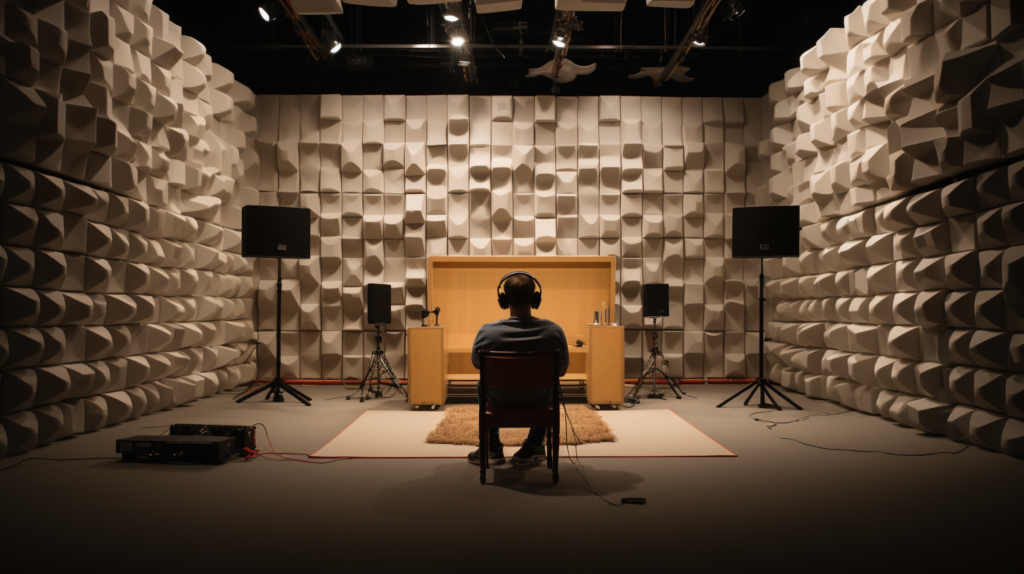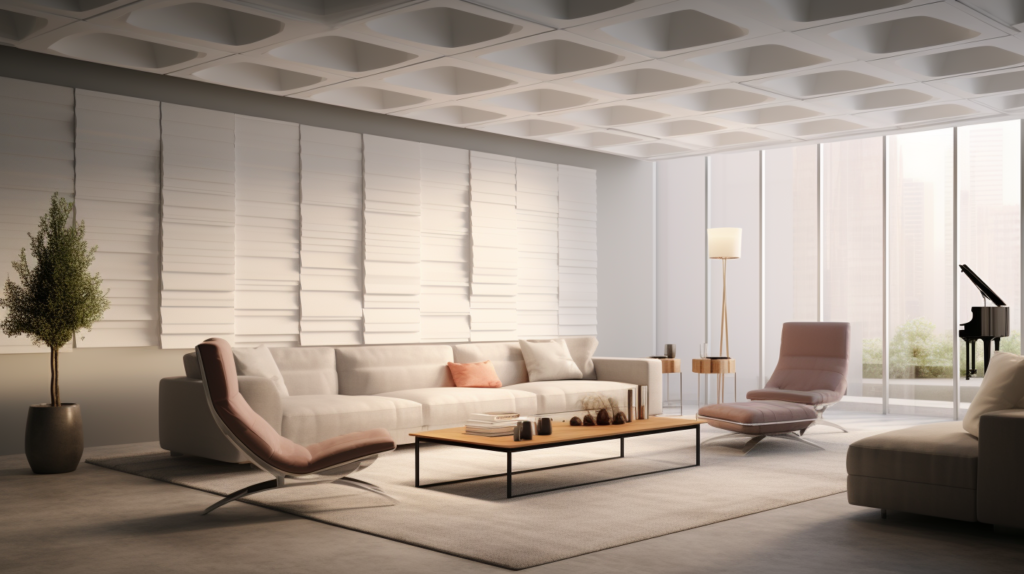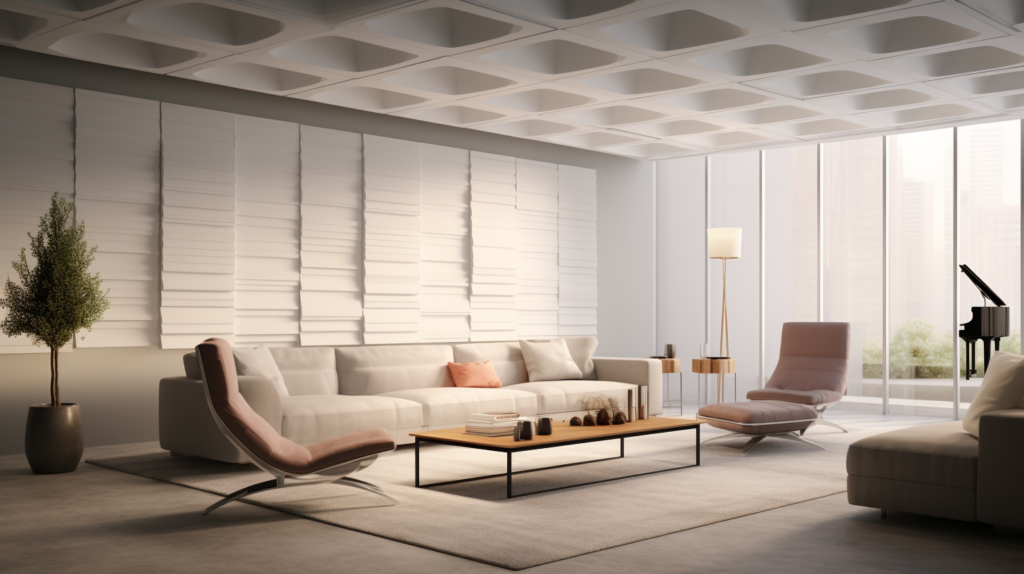With noisy neighbors, loud traffic, and thin apartment walls, finding ways to reduce noise pollution at home is a priority for many. Soundproof wallpaper promises an easy fix to make rooms quieter, but does it really work?
Despite bold claims from manufacturers, scientific testing shows that soundproof wallpaper does not deliver meaningful noise reduction. The minimal sound dampening provided fails to justify the cost.
Noise intrusion can negatively impact health, productivity and quality of life. Let’s dive in to understand why soundproof wallpaper falls short compared to proven acoustic treatments, and how to actually achieve quieter interiors.
What is Soundproof Wallpaper?

Soundproof wallpaper refers to wallpaper that is marketed as being able to absorb or block sound within a room. Manufacturers of soundproof wallpaper make claims that their products can help reduce echo and reverberation in a space.
These types of wallpaper often have a noise reduction rating (NRR) or sound transmission class (STC) rating as a way to quantify their supposed sound dampening abilities.
The selling point of soundproof wallpaper is that it can purportedly make a room quieter without requiring major renovations or construction projects.
The appeal of soundproof wallpaper is that it offers a seemingly quick and affordable way to minimally treat room acoustics and decrease noise.
Traditional soundproofing methods like adding mass loaded barriers or rebuilding walls with specialized materials can be prohibitively expensive and time consuming for many homeowners and renters.
Soundproof wallpaper provides an allegedly easier alternative that can be installed simply by adhering it to existing wall surfaces.
Manufacturers assert that these products can block exterior noises like traffic or noisy neighbors, as well as absorb echo and reverberation within a room. The marketing promises that rooms feel quieter and more private after installation.
Various brands of soundproof wallpaper claim that their products are able to reduce noise levels anywhere from 20% to 80% compared to an untreated wall.
They cite laboratory sound transmission tests and use technical jargon like NRC and STC ratings to convince customers that their wallpapers will effectively dampen noise.
Many brands tout their wallpaper as being made from materials like mass loaded vinyl or having trademarked sound dampening technologies.
Consumers are led to believe these characteristics give the wallpaper superior acoustic properties compared to regular wallpaper. However, real world results often fail to live up to the marketing hype.
Why Soundproof Wallpaper Doesn’t Work

There are a few key reasons why true soundproofing is unlikely to be achieved using wallpaper alone. First, the underlying physics of how sound waves propagate and interact with materials means that thin, porous materials like wallpaper will do little to block significant noise.
Sound waves have the ability to penetrate through lighter weight substances like paper and fabric with ease.
In order to effectively dampen noise, a material needs to have sufficient mass and density so that acoustic energy is either reflected or absorbed, rather than passing through the material.
Standard weight wallpaper lacks the heft needed to meaningfully impede sound waves.
Additionally, even wallpaper that has a high NRR or STC rating has minimal real-world impact when it comes to noticeable sound reduction. These ratings are not necessarily indicators of how wallpaper will perform when installed in a living space.
Independent lab tests have revealed that high-end, acoustically rated wallpaper provides only a marginal decrease in measured decibel levels. At best, a 1 to 2-decibel reduction may be measured when using soundproof wallpaper under ideal conditions.
For reference, a 3-decibel decrease is considered the minimum noise reduction that is perceptible to the human ear. So while soundproof wallpaper may slightly attenuate noise based on technical measurements, the difference will generally be imperceptible in practice.
There are a few reasons why the sound transmission ratings for wallpaper do not translate into real-world noise reduction. First, these ratings are determined in controlled lab conditions that are optimized to achieve the best possible performance.
The wallpaper is tested in pristine condition and mounted on special test wall surfaces. But when installed in a lived-in home, the wallpaper can become damaged, peeled, or punctured which compromises its acoustical properties.
Additionally, the underlying wall surface and construction play a significant role in noise dampening. If the wall itself is not adequately insulated and soundproofed, then applying wallpaper will have negligible impact.
Finally, reverberation within rooms is a major component of perceived noise levels. Since wallpaper does little to absorb reverberant sounds within a space, it fails to address this key aspect of interior acoustics.
For these reasons, real-world noise reduction is minimal.
Noise Reduction Testing Shows Minimal Sound Reduction

Multiple independent studies and lab tests have been conducted to analyze the real world sound dampening capabilities of wallpaper marketed as “soundproof.”
These tests consistently show that while some minimal sound blocking may occur, it is hardly enough to truly soundproof a room or living space.
In controlled environments designed to give soundproof wallpaper the best possible chance at reducing noise, the measured reduction has still only been in the range of 1-2 decibels.
Given that decibel levels are measured on a logarithmic scale, this small decrease translates to almost no perceptible change in loudness.
The consensus among acousticians is that soundproof wallpaper does not come anywhere close to the noise reduction levels achieved by purpose-built soundproofing materials and techniques.
For consumers hoping to effectively minimize noise intrusion or transmission between rooms, soundproof wallpaper will likely fail to deliver satisfactory results.
Consumer Reports is one of the organizations that has directly tested the sound dampening abilities of soundproof wallpaper products. They conducted controlled sound transmission tests using loudspeakers and sound meters to simulate typical household noise conditions.
Several name brand soundproof wallpaper samples were adhered to a test wall surface within a sound chamber.
Even in this ideal isolated environment, the results showed at most a 1 decibel reduction in transmitted noise when using the soundproof wallpaper compared to plain wallboard. This minor difference is negligible and would be completely imperceptible to listeners.
Critics point out that a 1 decibel decrease is only about a 20% reduction in sound energy. Given that human hearing perceives loudness on a logarithmic scale, this amount of noise reduction will be barely detectable even under the most sensitive conditions.
Based on their findings, Consumer Reports advised that soundproof wallpaper is not an effective solution for minimizing noise.
Their testing confirms the conclusions of acoustic engineers that these products do not have the mass or density required to provide meaningful sound dampening.
For consumers dealing with intrusive noises from neighbors, traffic, or other loud activities, soundproof wallpaper will likely lead to disappointment rather than noticeable relief.
“Soundproof” Claims Are Misleading

The labeling and marketing of wallpaper as “soundproof” is misleading to consumers who are hoping to reduce noise in their homes. These products prey on the very reasonable desire to have quieter interior spaces, but provide only an illusion of effective soundproofing.
Hanging soundproof wallpaper may visually make a room look like steps have been taken to minimize echo and outside noises, while not actually delivering on those promises.
The exaggerated or outright false claims about noise reduction capabilities give buyers unrealistic expectations about the results the wallpaper can achieve.
While there are materials that can significantly dampen sound when properly installed, standard weight wallpaper is not one of them.
But the pseudo-scientific labeling and impressive sounding acoustical ratings lead uninformed customers to believe they are purchasing a legitimate solution. In reality, soundproof wallpaper does not provide anything close to true soundproofing.
The Federal Trade Commission (FTC) has warned manufacturers against making deceptive claims about the sound dampening properties of wallpaper and other building materials.
They point out that terms like “soundproof” or “noise canceling” imply near complete elimination of noise, which misrepresents the actual capabilities of these products. The FTC advocates for truth in advertising when it comes to sound reduction claims.
Responsible marketers should convey that their products only minimally reduce, but do not eliminate, the transmission of sound.
Unfortunately, exaggeration and pseudo-scientific language are commonly used to market soundproof wallpaper. Manufacturers refer to meaningless certifications, fake acoustics research centers, and quasi-technical sound ratings intended to confuse buyers.
These tactics aim to exploit consumer lack of knowledge about the scientific principles behind noise reduction. But when scrutinized, most soundproof wallpaper lacks the mass, density, or special construction needed to significantly dampen noise.
At best, scientific testing shows 1-3 decibel reductions under optimal conditions – far from true soundproofing.
Responsible consumers should be wary of misleading marketing claims and skeptical of language like “laboratory certified soundproofing” or “proprietary noise eliminating technology”. Get the facts from objective experts rather than sales hype.
Consider Real Soundproofing Alternatives

Rather than waste money on soundproof wallpaper that does not live up to its claims, there are several real options for adding meaningful sound dampening to rooms.
For reducing airborne noise intrusion, a combination approach of using soundproofing foam, resilient channels, and multiple layers of drywall can effectively block external noise.
This leverages vibration damping, air pockets, and mass to prevent sound transmission through walls and ceilings. Soundproofing panels made from nitrile butadiene rubber is also an effective interior finish option for absorbing disruptive noises within a room.
For optimal results, it is best to work with an acoustical specialist to identify noise sources and strategically implement solutions that address sound at the source, before it reaches walls.
A professional assessment and purpose-built soundproofing plan will provide long-term noise reduction that superficial wallpaper applications cannot match.
Soundproofing foam applied to walls can help dampen vibrations and dissipate sound energy through its open cellular structure. This is effective at absorbing medium to high-frequency noise.
Resilient channels work by creating decoupled barrier layers that disrupt vibration transmission. Installing these between wall framing and drywall prevents noise transfer.
Finally, multiple layers of dense, heavyweight drywall add mass which impedes sound passage and improves transmission loss. Combining these technologies creates staggered sound barriers that effectively minimize airborne noise like loud music or conversations.
Conclusion: Don’t Waste Money on Soundproof Wallpaper

In summary, typical soundproof wallpaper does not have the mass, construction, or density required to meaningfully block or absorb noise.
The measured sound reduction capabilities are negligible, despite the impressive marketing claims and technical ratings used to sell these products.
The false illusion of soundproofing that this wallpaper provides may temporarily seem to help with noise issues, but the long-term results will inevitably disappoint.
Rather than waste money on a product that does not deliver on its claims, invest in authentic sound-dampening solutions. Focus time, effort, and budget on real noise-reducing methods like soundproofing construction materials, and professional soundproofing consultation.
For noticeable sound reduction that improves daily life, skip the soundproof wallpaper gimmicks and go with proven effective options.
The acoustics community adamantly recommends against soundproof wallpaper, instead advising more robust treatments. As experienced experts in their field, these professionals rely on scientifically-validated methodologies for noise control.
Mainstream soundproof wallpaper products do not pass evidence-based scrutiny when it comes to actually improving interior acoustics. No serious soundproofing contractor would propose peel-and-stick wallpaper as the solution to intrusive noises.
Yet exaggerated marketing claims prey on uninformed consumers who lack the expertise to filter fact from fiction.
Don’t settle for a superficial non-solution. Get real results from evidence-based soundproofing.
